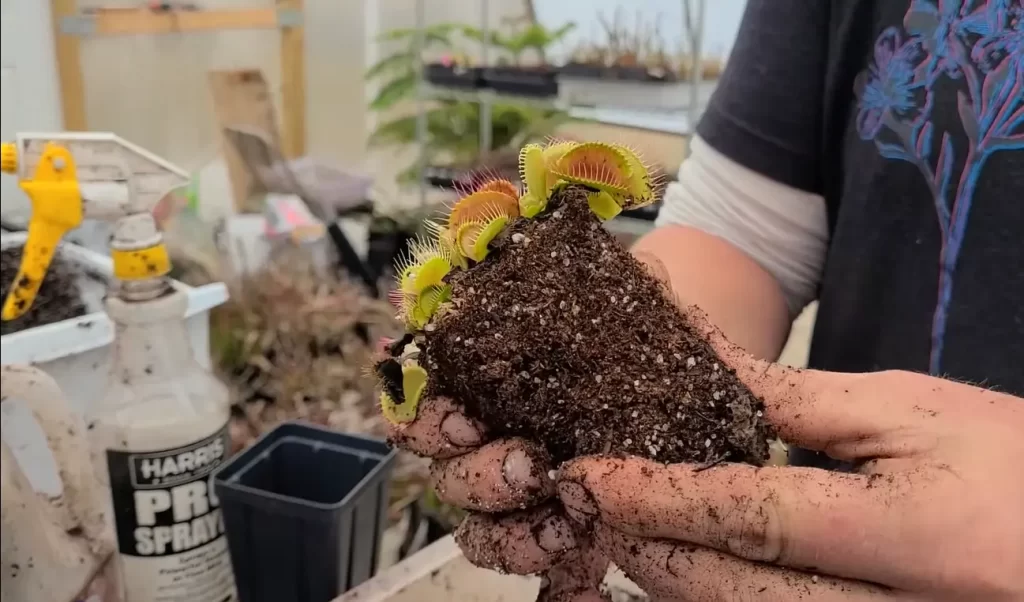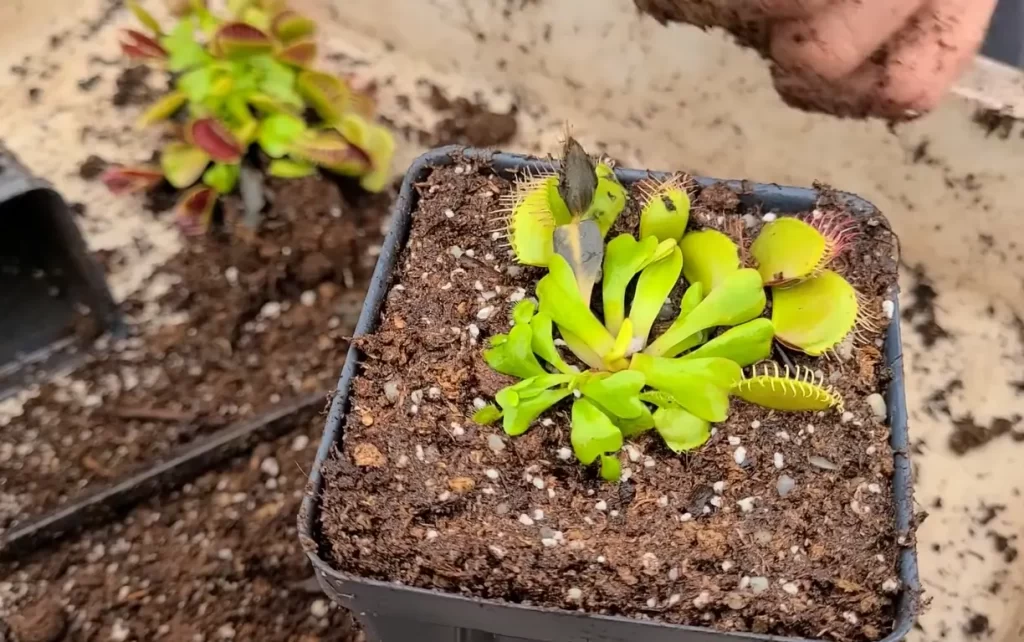How To Use Cactus Soil For Venus Flytrap: A – Z Guide
Venus Flytraps are unique and fascinating carnivorous plants that have captured the attention of plant enthusiasts worldwide. These plants are known for trapping and digesting insects, making them a popular addition to any plant collection.
However, Venus Flytraps require specific soil conditions to thrive, which can be tricky for novice growers. One common question among plant enthusiasts is: Can I use cactus soil for venus flytrap?
Yes, you can use cactus soil for Venus flytrap. Cacti and Venus fly traps have similar requirements and prefer good drainage and aeration soil.
In this blog post, we will explore the question in-depth and provide a comprehensive discussion to help you understand whether cactus soil is a good option for your Venus Flytrap.
What Does Cactus Soil Mean?
Cactus soil is a type of soil that is specifically formulated to meet the unique needs of cacti and other succulent plants. Even you can plant cacti together with Aloe Vera if you want. It typically contains a mixture of peat moss, sand, perlite, and sometimes silica sand.

These provide excellent drainage and moisture retention while preventing excess water from accumulating around the roots of the plants.
This soil type is also usually slightly acidic, which helps create an ideal environment for these plants to thrive in. Cactus soil is important for these plants to ensure proper care, especially during winter or in low-light environments.
Anatomy of a Venus Flytrap Plant
The Venus Flytrap is a carnivorous plant that grows in nutrient-free soil, such as peat moss, silica sand, and perlite. It requires consistent moisture, but excess water can lead to root rot, so adequate drainage is necessary.
The plant is characterized by its unique trap-shaped leaves, which use a sensitive trigger mechanism to snap shut and capture prey. The roots are relatively small, and the plant is generally small, growing to a maximum of a few inches.
It prefers acidic soil and bright, indirect sunlight; during the winter, it can be cared for with standard potting soil.
Can I Use Cactus Soil For Venus Flytrap?
Yes, cactus soil can be used for Venus Fly Traps. However, you’ll need to mix the cactus soil with other materials to create a suitable environment for the plant. A mixture of peat moss, perlite, and silica sand can be added to improve drainage and moisture retention.
Note that Venus Fly Traps require acidic soil with a pH between 4.5 and 5.5. They also need to be kept moist but not waterlogged and placed in a location with bright, indirect sunlight. During the winter, the plant should be kept in a cooler environment to encourage dormancy.
How to Use Cactus Soil for Venus Flytrap Plants
Cactus soil is recommended for Venus Flytrap plants due to its nutrient-free and well-draining properties. Here, we will discuss how to use cactus soil for Venus Flytrap plants.
1. Choosing the Right Soil
Venus Flytrap plants to require acidic soil with a pH between 4.5 and 5.5. Cactus soil is typically acidic, making it an ideal choice for Venus Flytrap plants. You can find cactus soil at most garden centers or online.
2. Mixing the Soil
While cactus soil is a suitable option for Venus Flytrap plants, mixing it with other components is recommended to create a more optimal environment for your plants.
A mixture of peat moss, silica sand, and perlite can be added to cactus soil to create a nutrient-free and well-draining soil mixture. The ratio of the mixture should be one part cactus soil, one part peat moss, one part silica sand, and one part perlite.
3. Preparing the Pot
It is essential to use a pot with proper drainage holes to ensure adequate drainage. You can add a layer of gravel or small rocks at the bottom of the pot to create additional drainage. Fill the pot with the soil mixture, leaving about an inch of space at the top.
4. Planting the Venus Flytrap
Before planting the Venus Flytrap, it is important to examine the roots. If you
notice any signs of root rot or black roots, trim them off. Place the plant in the center of the pot and gently cover the roots with soil. It is crucial not to bury the leaves or traps in the soil.
5. Watering the Venus Flytrap
Venus Flytrap plants require a delicate balance of moisture. It is recommended to water them with room-temperature distilled water or rainwater. You can place the pot in a water tray to allow the plant to absorb water from the bottom. However, empty any excess water after about 30 minutes to prevent waterlogging.
6. Caring for the Venus Flytrap
Venus Flytrap plants require a lot of direct sunlight, so placing them where they can receive at least 6 hours of direct sunlight per day is recommended. During winter, the plant can be placed under grow lights to ensure it receives enough light.
Benefits of Using Cactus Soil for Venus Flytrap Plants
Cactus soil is one type of soil that can benefit Venus flytrap plants in many ways. Here, we will discuss the benefits of using cactus soil for Venus flytrap plants.
Soil
Cactus soil is a type of soil that is suitable for Venus flytrap plants. It comprises a mixture of peat moss, perlite, sand, and sometimes silica sand. This mixture provides the perfect environment for Venus flytraps to grow in. Cactus soil is free of nutrients, which is ideal for Venus flytrap plants as they don’t need a lot of nutrients to survive.
Water
Venus flytrap plants require moist soil but don’t like sitting in water. Cactus soil is well-draining, so excess water can easily drain away. This prevents the soil from becoming waterlogged, which can lead to root rot and other issues. Using room-temperature distilled water or rainwater is recommended to avoid chemicals found in tap water.
Root
Venus flytrap plants have a shallow root system. Cactus soil provides the perfect environment for their roots to grow. The soil allows for adequate airflow, which is important for the health of the roots.
Traps and Leaves
Venus flytrap plants have unique traps and leaves that require a certain environment to thrive. Cactus soil provides the right balance of moisture retention and drainage, which allows the traps and leaves to function properly. The soil also promotes healthy growth and development of the plant.
Winter
Venus flytrap plants require a period of dormancy during the winter months. Cactus soil is ideal for this period, allowing for adequate airflow and moisture retention. The soil also prevents excess moisture from building up, which can lead to issues during the dormant period.
Alternatives to Cactus Soil for Venus Flytrap Plants
While cactus soil is a common choice for growing Venus flytrap plants, several alternatives can be used to provide the necessary conditions for their growth.

Here, we will explore some of the options available and how they can benefit your Venus flytrap plants.
1. Succulent Soils
Succulent soils are an excellent alternative to cactus soil for Venus flytrap plants. They are specially formulated to provide excellent drainage and moisture retention, which are crucial for the growth of these carnivorous plants.
Typically, succulent soils are typically a mixture of organic materials such as peat moss, perlite, and sand. They are designed to be nutrient-free, essential for Venus flytrap plants, as they derive all their nutrients from the insects they catch.
2. Carnivorous Plant Soil
Carnivorous plant soil is another excellent option for growing Venus flytrap plants. It is specifically designed to meet the unique needs of carnivorous plants, including Venus flytraps.
This soil mix is typically made of peat moss, silica sand, and perlite. It is nutrient-free and provides the necessary acidity that Venus flytrap plants require for optimal growth.
3. Acidic Soil
Venus flytrap plants require acidic soil to grow properly. You can create your own acidic soil mix if you cannot find a carnivorous plant soil mix. To do this, you will need to mix one part peat moss with one part silica sand or perlite. This will create a nutrient-free, well-draining soil that is slightly acidic.
4. Standard Potting Soil
Standard potting soil can be used as an alternative to cactus soil for Venus flytrap plants, but it is not the best option. Most standard potting soils are too nutrient-rich for these carnivorous plants, which can cause root burn and damage.
However, if you cannot find any of the other options listed above, a 50/50 blend of standard potting soil and perlite can be used.
Wrapping Up
The answer to the question “Can I use cactus soil for venus fly trap?” is yes. Cactus soil is a great option for Venus Fly Traps because it contains enough nutrients and moisture for the plant to thrive.
Additionally, the soil is lightweight and easy to work with. However, you should ensure the soil is not too acidic and add extra peat moss or sand if needed. With the right preparation, cactus soil can create a healthy environment for Venus Fly Traps to grow.
